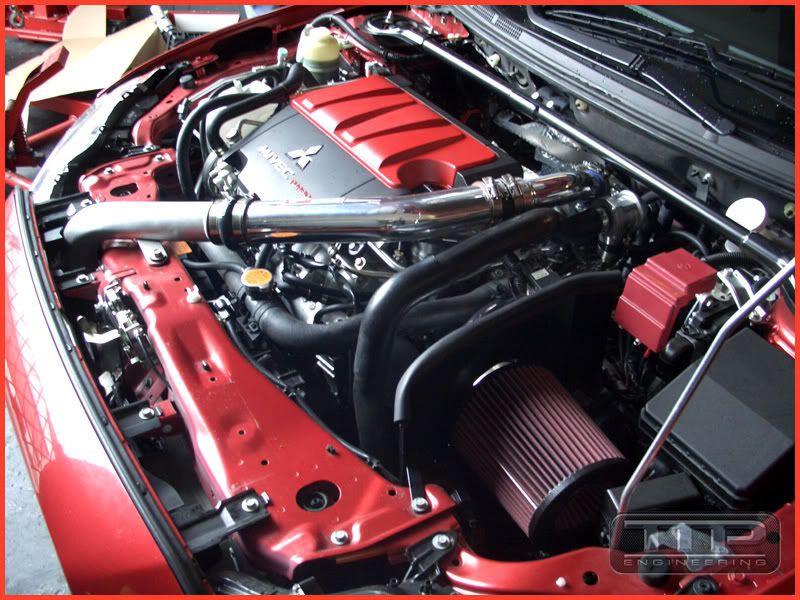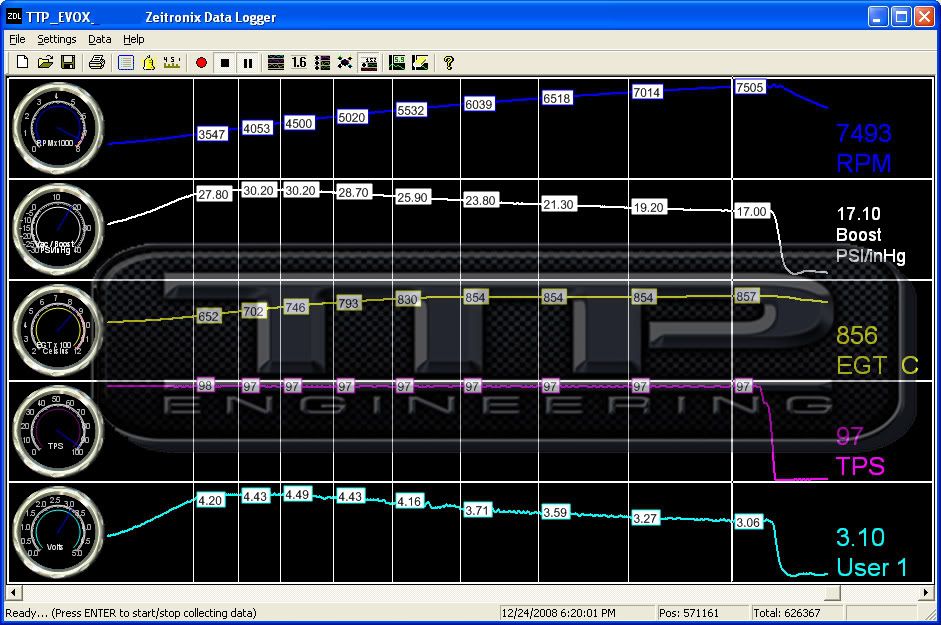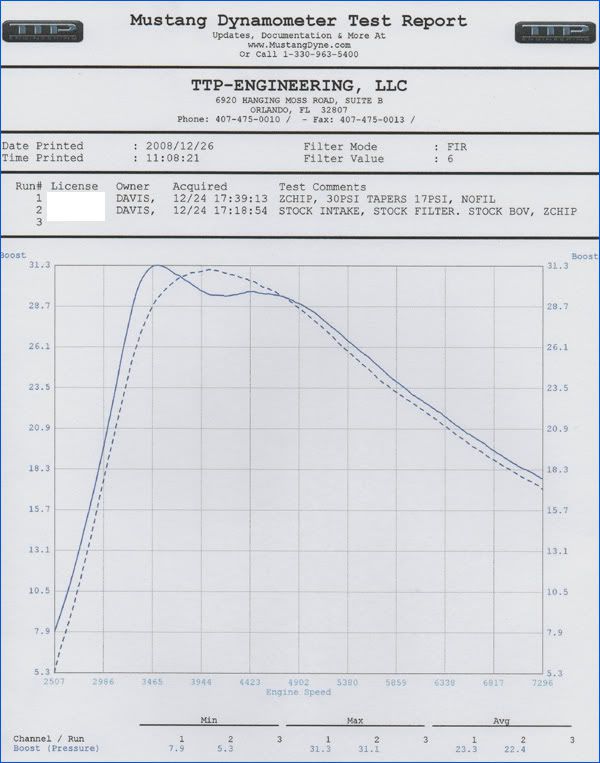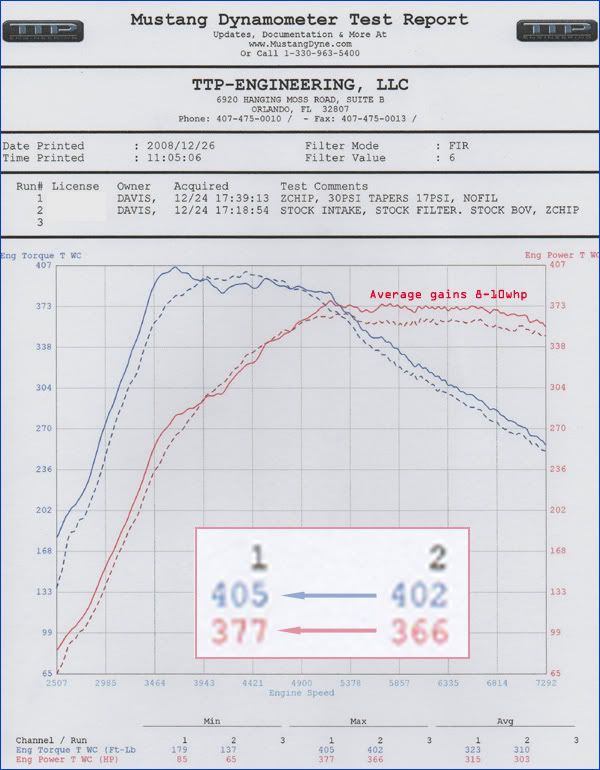What is an INTAKE really worth when you are TUNED?
#1
What is an INTAKE really worth when you are TUNED?
For some time now we have discussed what the definition of a high performance intake system means to us and why WE believe one should be used on a vehicle.
There are a number of aftermarket "performance" intakes available in the marketplace for an Evo X performance minded consumer to invest their money in.

We could go along with the flow of things and try and sell and aftermarket intake to every potential buyer that calls or comes into the shop here, trying to earn a commission on each sale, but thats just not how we work.
We actually mirror and enjoy testing the limits and taking the time to fully dynotest everything we work with much like our buddy David Buschur has done on the Evo 8-9's and now X's. One of his best threads ever was his continued dynotesting of aftermarket parts on the Evo 8-9's and for that we appreciate his time, testing and most importantly the time taken to provide the information to the forum.
With that said, we have just completed our first stage of modifications and testing on our own 2008 Evo GSR.

First of all this NEW Evo X has a totally different type of mass airflow meter. It is NOT like the Evo 8-9 karman vortex meter which is subject to large changes in readings based on the type of filter chosen to use. In the past filters such as the HKS RS intake would LOWER the MAF signal in turn leaning out the fueling and increasing ignition timing whereas the APEXi intake cone would RAISE the MAF reading which would add fueling and reduce timing, make the car hit boost cut limits much faster.

Since the Evo X 4b11t MAF sensor is a hotwire type, it basically consists of wire with voltage applied to it. A constant voltage is applied to the heated wire. This wire is positioned in the air stream or in an airflow sampling channel and is heated by the electrical current that the voltage produces. As air flows across it, it cools down. The heated wire or film is a positive temperature coefficient (ptc) resistor. This means that it's resistance drops when it's temperature drops.The drop in resistance allows more current to flow through it in order to maintain the programmed temperature. This current is changed to a frequency or a voltage which is sent to the computer and interpreted as air flow. Adjustments for air temperature and humidity are taken into consideration since they also affect the temperature of the heated wire and this is how airflow measurement is determined. This is why filter type does not affect MAF readings very much as it is not measuring SOUND (karman vortecies) as with the 2001-2006 Evo 7-9.
One of OUR pet peeves is intakes such as the HKS RS which in our opinion is designed specifically to reduce the MAF signal and increase performance by increasing ignition timing and leaning out the AFR. This is a job we believe should all be addressed in TUNING, not by the intake itself. We firmly believe that an INTAKE system should be responsible for its own job of increasing airflow and making power by that sole responsibility.
There are a lot of intakes in the market for the X. Which ones actually flow more air and make power without increasing boost or leaning the AFR, raising ignition timing? Do any???
In our dynotesting, we decided to take some stock parts to their limit and actually test if the stock parts actually NEED to be replaced in order to remove restrictions or bottlenecks in the performance of the engine.
One of the tests we did was to take the car to 30psi run full tilt and tuned, AT THAT POINT, then remove the "restriction" stock air filter and measure the difference in performance, AFR, BOOST, torque and WHP. This test is able to be run on this vehicle because it is a hotwire MAF as it would not work on a karman vortex airflow meter like the EVO 7-9 as it would change the LOAD in the ECU as well as timing and AFR.
Here is a datalog of a 30psi pull and the boost curve associated with our testing.

Here are the results of the dynotest before and after.
 The test was completed within 19 minutes of each other back to back.
The test was completed within 19 minutes of each other back to back.
 The ECU controlled boost maps remained the same.
The ECU controlled boost maps remained the same.
 The TUNING was unchanged.
The TUNING was unchanged.
The result in boost was about 0.5psi on average increased from removing the filter from about 4900rpms to redline.

The results in power and torque were only about 10-11whp peak to peak and an average of about 8-10whp across the board from 4900rpms-redline.

Our summary is that the stock intake/filter is well designed from Mitsubishi and there is not a great restriction in the intake to start with. When you are searching for power and performance gains from an intake system that actually flows better and you allow TUNING to take care of AFR, TIMING and BOOST and the intake to flow the air which it is its job to do, then the gains from an intake system based on the notion that one FLOWS better than the stock intake are very low, but notable.
For those of you that do not plan to have the Evo X TUNED for the modifications used, then there are other intake systems available that WILL change the MAF readings from using a larger MAF housing for the stock sensor to be transfered over to. There will also be intake systems that will use multiple boost control solenoid hoses in order to raise boost over stock.
For those of you that have no plans to be professionally tuned, these might be options for you. However for the ones that will be tuned by ZChip, reflash, another professional method, then the aftermarket intakes may not benefit you very much and a dry panel filter or cone may suit your needs better. Just don't expect huge numbers from an intake alone.
There are a number of aftermarket "performance" intakes available in the marketplace for an Evo X performance minded consumer to invest their money in.

We could go along with the flow of things and try and sell and aftermarket intake to every potential buyer that calls or comes into the shop here, trying to earn a commission on each sale, but thats just not how we work.
We actually mirror and enjoy testing the limits and taking the time to fully dynotest everything we work with much like our buddy David Buschur has done on the Evo 8-9's and now X's. One of his best threads ever was his continued dynotesting of aftermarket parts on the Evo 8-9's and for that we appreciate his time, testing and most importantly the time taken to provide the information to the forum.
With that said, we have just completed our first stage of modifications and testing on our own 2008 Evo GSR.

First of all this NEW Evo X has a totally different type of mass airflow meter. It is NOT like the Evo 8-9 karman vortex meter which is subject to large changes in readings based on the type of filter chosen to use. In the past filters such as the HKS RS intake would LOWER the MAF signal in turn leaning out the fueling and increasing ignition timing whereas the APEXi intake cone would RAISE the MAF reading which would add fueling and reduce timing, make the car hit boost cut limits much faster.

Since the Evo X 4b11t MAF sensor is a hotwire type, it basically consists of wire with voltage applied to it. A constant voltage is applied to the heated wire. This wire is positioned in the air stream or in an airflow sampling channel and is heated by the electrical current that the voltage produces. As air flows across it, it cools down. The heated wire or film is a positive temperature coefficient (ptc) resistor. This means that it's resistance drops when it's temperature drops.The drop in resistance allows more current to flow through it in order to maintain the programmed temperature. This current is changed to a frequency or a voltage which is sent to the computer and interpreted as air flow. Adjustments for air temperature and humidity are taken into consideration since they also affect the temperature of the heated wire and this is how airflow measurement is determined. This is why filter type does not affect MAF readings very much as it is not measuring SOUND (karman vortecies) as with the 2001-2006 Evo 7-9.
One of OUR pet peeves is intakes such as the HKS RS which in our opinion is designed specifically to reduce the MAF signal and increase performance by increasing ignition timing and leaning out the AFR. This is a job we believe should all be addressed in TUNING, not by the intake itself. We firmly believe that an INTAKE system should be responsible for its own job of increasing airflow and making power by that sole responsibility.
There are a lot of intakes in the market for the X. Which ones actually flow more air and make power without increasing boost or leaning the AFR, raising ignition timing? Do any???
In our dynotesting, we decided to take some stock parts to their limit and actually test if the stock parts actually NEED to be replaced in order to remove restrictions or bottlenecks in the performance of the engine.
One of the tests we did was to take the car to 30psi run full tilt and tuned, AT THAT POINT, then remove the "restriction" stock air filter and measure the difference in performance, AFR, BOOST, torque and WHP. This test is able to be run on this vehicle because it is a hotwire MAF as it would not work on a karman vortex airflow meter like the EVO 7-9 as it would change the LOAD in the ECU as well as timing and AFR.
Here is a datalog of a 30psi pull and the boost curve associated with our testing.

Here are the results of the dynotest before and after.
 The test was completed within 19 minutes of each other back to back.
The test was completed within 19 minutes of each other back to back. The ECU controlled boost maps remained the same.
The ECU controlled boost maps remained the same. The TUNING was unchanged.
The TUNING was unchanged.The result in boost was about 0.5psi on average increased from removing the filter from about 4900rpms to redline.

The results in power and torque were only about 10-11whp peak to peak and an average of about 8-10whp across the board from 4900rpms-redline.

Our summary is that the stock intake/filter is well designed from Mitsubishi and there is not a great restriction in the intake to start with. When you are searching for power and performance gains from an intake system that actually flows better and you allow TUNING to take care of AFR, TIMING and BOOST and the intake to flow the air which it is its job to do, then the gains from an intake system based on the notion that one FLOWS better than the stock intake are very low, but notable.
For those of you that do not plan to have the Evo X TUNED for the modifications used, then there are other intake systems available that WILL change the MAF readings from using a larger MAF housing for the stock sensor to be transfered over to. There will also be intake systems that will use multiple boost control solenoid hoses in order to raise boost over stock.
For those of you that have no plans to be professionally tuned, these might be options for you. However for the ones that will be tuned by ZChip, reflash, another professional method, then the aftermarket intakes may not benefit you very much and a dry panel filter or cone may suit your needs better. Just don't expect huge numbers from an intake alone.
Last edited by TTP Engineering; Dec 26, 2008 at 10:50 AM.
#3
Our summary is that the stock intake/filter is well designed from Mitsubishi and there is not a great restriction in the intake to start with. When you are searching for power and performance gains from an intake system that actually flows better and you allow TUNING to take care of AFR, TIMING and BOOST and the intake to flow the air which it is its job to do, then the gains from an intake system based on the notion that one FLOWS better than the stock intake are very low, but notable.
For those of you that do not plan to have the Evo X TUNED for the modifications used, then there are other intake systems available that WILL change the MAF readings from using a larger MAF housing for the stock sensor to be transfered over to. There will also be intake systems that will use multiple boost control solenoid hoses in order to raise boost over stock.
For those of you that have no plans to be professionally tuned, these might be options for you. However for the ones that will be tuned by ZChip, reflash, another professional method, then the aftermarket intakes may not benefit you very much and a dry panel filter or cone may suit your needs better. Just don't expect huge numbers from an intake alone.
For those of you that do not plan to have the Evo X TUNED for the modifications used, then there are other intake systems available that WILL change the MAF readings from using a larger MAF housing for the stock sensor to be transfered over to. There will also be intake systems that will use multiple boost control solenoid hoses in order to raise boost over stock.
For those of you that have no plans to be professionally tuned, these might be options for you. However for the ones that will be tuned by ZChip, reflash, another professional method, then the aftermarket intakes may not benefit you very much and a dry panel filter or cone may suit your needs better. Just don't expect huge numbers from an intake alone.
#5
Evolving Member
iTrader: (11)
Join Date: Mar 2008
Location: Florida
Posts: 126
Likes: 0
Received 0 Likes
on
0 Posts
These results are just like other intake tests compared with some other performance car factory intake debates I've seen. In the end the OEM intakes are not as restrictive as some claimed to be. Maybe eventually it will be the bottle neck, but you are probably making crazy HP numbers to need an alternative intake. It is very interesting though that it performs well from the factory.
#6
Evolved Member
iTrader: (12)
I have a huge question about the INJEN intake system. Where the heck does it get it's majority of air flow from if the heatshield that is include is blocking the nose airflow? Also along with the 90 degree bend, no longer is the air directed straight thru into the pipe. Does that make the INJEN intake system pointless compared to directed air flow systems like the OEM airbox or AEM's intake system?
Trending Topics
#8
Former Sponsor
Join Date: Sep 2005
Location: Chicagoland
Posts: 984
Likes: 0
Received 0 Likes
on
0 Posts
Maybe I missed something.
#9
In this statement it seems to me that you removed the stock filter and retested. Based on that, I am curious how you came to the decision that the stock intake was designed well. This test clearly shows the difference in power from just the filter and has nothing to do with the intake.
Maybe I missed something.
Maybe I missed something.
The chances of finding an intake pipe and filter that flow more freely than a stock intake with no filter restriction is very unlikely.
#10
Former Sponsor
Join Date: Sep 2005
Location: Chicagoland
Posts: 984
Likes: 0
Received 0 Likes
on
0 Posts
We removed the largest restriction from the intake which was the filter to demonstrate what the impact is without restriction. Most aftermarket intake pipes are of similar size and the intake pipe itself is a relatively short pipe to the turbo inlet.
The chances of finding an intake pipe and filter that flow more freely than a stock intake with no filter restriction is very unlikely.
The chances of finding an intake pipe and filter that flow more freely than a stock intake with no filter restriction is very unlikely.
I cant imagine that the convoluted tubing of the factory intake which is smaller in diameter than the MAF housing would flow as much as a mandrel bent tubing the same size as the MAF housing. I am sure we have tested the stock intake versus the AMS intake and can post up dyno charts to show the gains. I will have to check with Chris on Monday.
In addition to the better flow from the larger diameter smooth piping, the AMS intake relocates the factory BOV to reduce the amount of piping the turbo needs to pressurize which will improve spool. The AMS cold air intake moves the filter outside of the engine compartment keeping the charge air cooler improving power and spool.
The last thing I want to do is start an argument, but I want to make sure that people are clear that an "intake" was not tested to come to your conclusion and not all of the benefits of an intake were addressed in the testing.
#13
One issue that we have seen with conical types of intakes is that the radiator fan blows directly on them which is not performance oriented as hot air does not make power. Furthermore the air from the fan can upset the MAF metering as it blows into the intake filter.
Injen for example may have found this out which is likely the reason the INJEN intake has the corridor separating the filter from the radiator fan path.

This should answer both posts at once.

#14
Former Sponsor
Join Date: Sep 2005
Location: Chicagoland
Posts: 984
Likes: 0
Received 0 Likes
on
0 Posts
I am not familiar with the Z Chip or what tuning functions it has so I can not comment on how that affects the outcome of the test.
One issue that we have seen with conical types of intakes is that the radiator fan blows directly on them which is not performance oriented as hot air does not make power. Furthermore the air from the fan can upset the MAF metering as it blows into the intake filter.
Injen for example may have found this out which is likely the reason the INJEN intake has the corridor separating the filter from the radiator fan path.
This should answer both posts at once.
Injen for example may have found this out which is likely the reason the INJEN intake has the corridor separating the filter from the radiator fan path.
This should answer both posts at once.


The AMS short ram intake comes with a shield to keep the radiator fan air from blowing into the filter.

The AMS cold air moves the filter outside the engine compartment eliminating the possibility of radiator fan air entering the filter.


